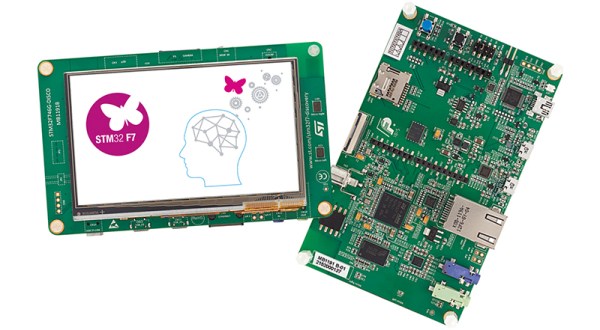It was announced last year, but ST is finally rolling out the STM32F7, the first microcontroller in production that is based on the ARM Cortex-M7.
The previous go-to part from the ST catalog was the STM32F4, an extremely powerful chip based on the ARM Cortex M4 processor. This chip was incredibly powerful in its time, and is still a respectable choice for any application that needs a lot of horsepower, but not a complete Linux system. We’ve seen the ~F4 chip pump out 800×600 VGA, drive a thermal imaging camera, and put OpenCV inside a webcam. Now there’s a new, even more powerful part on the market, and the mind reels thinking what might be possible.
Right now there a few STM32F7 parts out, both with speeds up to 216MHz, Flash between 512k and 1MB, and 320kB of RAM. Peripherals include Ethernet, USB OTG, SPDIF support, and I²S. The most advanced chip in the line includes a TFT LCD controller, and a crypto processor on-chip. All of the chips in the STM32F7 line are pin compatible with the STM32F4 line, with BGA and QFP packages available.
As with the introduction of all of ST’s microcontrollers, they’re rolling out a new Discovery board with this launch. It features Ethernet, a bunch of audio peripherals, USB OTG, apparently an Arduino-style pin layout, and a 4.3 inch, 480×272 pixel LCD with capacitive touch. When this is available through the normal distributors, it will sell for around $50. The chips themselves are already available from some of the usual distributors, for $17 to $20 in quantity one. That’s a chunk of change for a microcontroller, but the possibilities for what this can do are really only limited by an engineer’s imagination.













